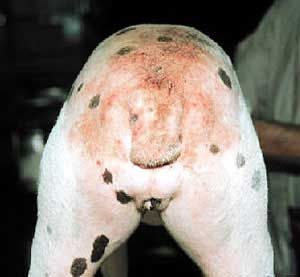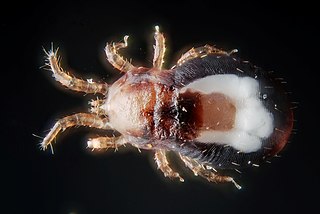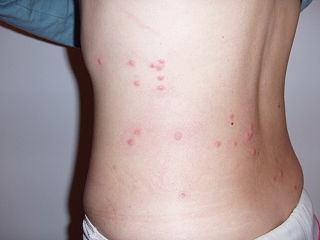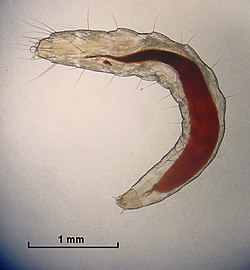
Flea, the common name for the order Siphonaptera, includes 2,500 species of small flightless insects that live as external parasites of mammals and birds. Fleas live by ingesting the blood of their hosts. Adult fleas grow to about 3 millimetres long, are usually brown, and have bodies that are "flattened" sideways or narrow, enabling them to move through their hosts' fur or feathers. They lack wings; their hind legs are extremely well adapted for jumping. Their claws keep them from being dislodged, and their mouthparts are adapted for piercing skin and sucking blood. They can leap 50 times their body length, a feat second only to jumps made by another group of insects, the superfamily of froghoppers. Flea larvae are worm-like, with no limbs; they have chewing mouthparts and feed on organic debris left on their hosts' skin.
Toxocariasis is an illness of humans caused by the dog roundworm and, less frequently, the cat roundworm. These are the most common intestinal roundworms of dogs, coyotes, wolves and foxes and domestic cats, respectively. Humans are among the many "accidental" or paratenic hosts of these roundworms.
Spirometra is a genus of pseudophyllid cestodes that reproduce in canines and felines, but can also cause pathology in humans if infected. As an adult, this tapeworm lives in the small intestine of its definitive host and produces eggs that pass with the animal's feces. When the eggs reach water, the eggs hatch into coracidia which are eaten by copepods. The copepods are eaten by a second intermediate host to continue the life cycle. Humans can become infected if they accidentally eat frog legs or fish with the plerocercoid stage encysted in the muscle. In humans, an infection of Spirometra is termed sparganosis.

Dipylidium caninum, also called the flea tapeworm, double-pored tapeworm, or cucumber tapeworm is a cyclophyllid cestode that infects organisms afflicted with fleas and canine chewing lice, including dogs, cats, and sometimes human pet-owners, especially children.

Tunga penetrans is a species of flea also known as the jigger, jigger flea, chigoe, chigo, chigoe flea, chigo flea, nigua, niknik, sand flea, or burrowing flea. It is a parasitic insect found in most tropical and sub-tropical climates. In its parasitic phase it has significant impact on its hosts, which include humans and certain other mammalian species. A parasitical infestation of T. penetrans is called tungiasis. Jiggers are often confused with chiggers, a type of mite. Jiggers are native to Central and South America, and have been introduced to sub-Saharan Africa.
Acanthocheilonema is a genus within the family Onchocercidae which comprises mainly tropical parasitic worms. Cobbold created the genus Acanthocheilonema with only one species, Acanthocheilonema dracunculoides, which was collected from aardwolf in the region of South Africa in the nineteenth century. These parasites have a wide range of mammalian species as hosts, including members of Carnivora, Macroscelidea, Rodentia, Pholidota, Edentata, and Marsupialia. Many species among several genera of filarioids exhibit a high degree of endemicity in studies done on mammalian species in Japan. However, no concrete evidence has confirmed any endemic species in the genus Acanthocheilonema.

Cheyletiella is a genus of mites that live on the skin surface of dogs, cats, and rabbits.

Flea allergy dermatitis is an eczematous itchy skin disease of dogs and cats. For both of these domestic species, flea allergy dermatitis is the most common cause of skin disease. Affected animals develop allergic reactions to chemicals in flea saliva. Symptoms of this reaction include erythema (redness), papules (bumps), pustules, and crusts (scabs). If severe, hair loss will occur in the affected area. Dogs with flea allergy dermatitis often show hair loss and eczematous skin rash on the lower back, upper tail, neck, and down the back of the legs. Cats with flea allergy dermatitis may develop a variety of skin problems, including feline eosinophilic granuloma, miliary dermatitis, or self-inflicted alopecia from excessive grooming.

Dermanyssus gallinae is a haematophagous ectoparasite of poultry. It has been implicated as a vector of several major pathogenic diseases. Despite its common names, it has a wide range of hosts including several species of wild birds and mammals, including humans. In both size and appearance, it resembles the northern fowl mite, Ornithonyssus sylviarum.

The human flea – once also called the house flea – is a cosmopolitan flea species that has, in spite of the common name, a wide host spectrum. It is one of six species in the genus Pulex; the other five are all confined to the Nearctic and Neotropical realms. The species is thought to have originated in South America, where its original host may have been the guinea pig or peccary.

Thelazia callipaeda is a parasitic nematode, and the most common cause of thelaziasis in humans, dogs and cats. It was first discovered in the eyes of a dog in China in 1910. By 2000, over 250 human cases had been reported in the medical literature.

Thelaziasis is the term for infestation with parasitic nematodes of the genus Thelazia. The adults of all Thelazia species discovered so far inhabit the eyes and associated tissues of various mammal and bird hosts, including humans. Thelazia nematodes are often referred to as "eyeworms".

Ancylostoma braziliense is a species of hookworm belonging to the genus Ancylostoma. It is an intestinal parasite of domestic cats and dogs. Severe infection is often fatal to these pets, especially in puppies and kittens. The infection is particularly endemic in the southern United States. It is most often confused with the zoonotic hookworm species Ancylostoma ceylanicum because of their uncanny resemblance.

Pulicosis is a skin condition caused by several species of fleas, including the cat flea and dog flea. This condition can range from mild irritation to severe irritation. In some cases, 48 to 72 hours after being bitten, a more severe rash-like irritation may begin to spread across the body. Symptoms include swelling of the bitten area, erythema, ulcers of the mouth and throat, restlessness, and soreness of the areolae. In extreme cases, within 1 week after being bitten, the condition may spread through the lymph nodes and begin affecting the central nervous system. Permanent nerve damage can occur.

Echidnophaga gallinacea, also known as the hen flea or sticktight flea, is part of the 2,500 known flea types in the Siphonaptera order. Echidnophaga gallinacea appear dark brown in colour and is a small flea measuring approximately 2 millimetres in length, which is half the size of the common cat flea. Echidnophaga gallinacea also differ in anatomy compared to the cat flea due to lacking genal and pronotal combs known as ctenidia. Echidnophaga gallinacea like all fleas, have powerful hind legs which allow the flea to jump great distances compared to its size.

The dog flea is a species of flea that lives as an ectoparasite on a wide variety of mammals, particularly the domestic dog and cat. It closely resembles the cat flea, Ctenocephalides felis, which can live on a wider range of animals and is generally more prevalent worldwide.

The Pulicidae are a flea family in the order Siphonaptera. Currently, this family has 181 species in 27 genera. Of these, 16 are known from North America.

Ctenocephalides is a flea genus in the tribe Archaeopsyllini which includes the cat flea, Ctenocephalides felis and the dog flea, C canis. Species and subspecies in the genus infest a wide variety of hosts, including sheep and goats, wild carnivores, hares, hyraxes, ground squirrels and hedgehogs.

Mites that infest and parasitize domestic animals cause disease and loss of production. Mites are small invertebrates, most of which are free living but some are parasitic. Mites are similar to ticks and both comprise the order Acari in the phylum Arthropoda. Mites are highly varied and their classification is complex; a simple grouping is used in this introductory article. Vernacular terms to describe diseases caused by mites include scab, mange, and scabies. Mites and ticks have substantially different biology from, and are classed separately from, insects. Mites of domestic animals cause important types of skin disease, and some mites infest other organs. Diagnosis of mite infestations can be difficult because of the small size of most mites, but understanding how mites are adapted to feed within the structure of the skin is useful.
Flea treatments are procedures used to treat flea infestations in human or animal populations. They may treat both the itching caused by bites and may remove or kill the fleas themselves.





















